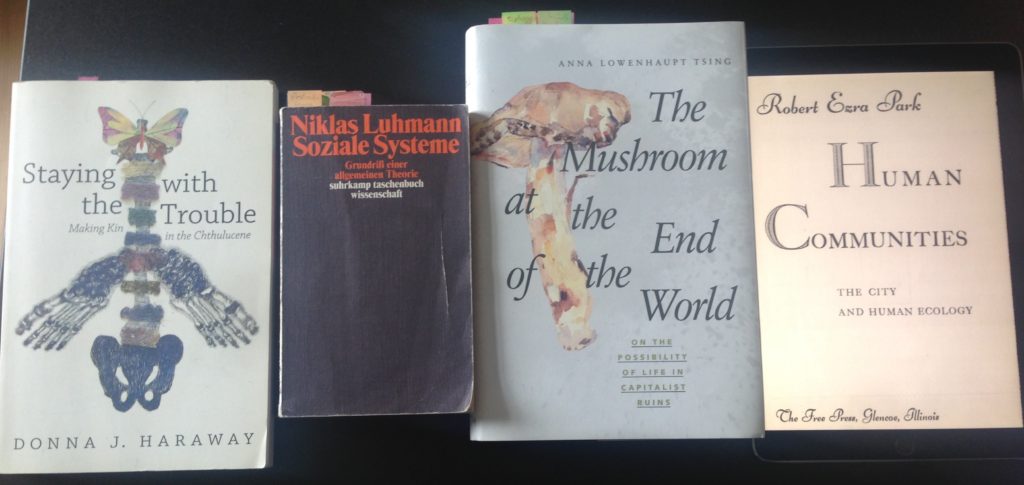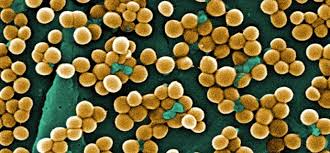Our project seeks to explore “symbiosis” through a focus on three topics: symbiotic collectives, symbiotic theories, and symbiotic engineering.
Symbiotic Collectives

“We are all lichens now!” (Scott Gilbert)! Symbiosis is a particular mode of “being-“ and “becoming-with” (Donna Haraway). It is a form of being-collective in an equally embodied and interested sense. Even though the concept of symbiosis originated in biology, it addresses questions that are at the core of sociology: how do we exist with others, how can we conceptualize plural beings, what ties an individual to others?
Symbiosis offers several answers to these questions. There are mutualistic forms of symbiosis where each organism benefits from the other, but also parasitic forms where one organism exploits the other. Like in a society, most of the time a symbiosis is not a passionate togetherness, but a disinterested being-alongside – at least until something goes wrong. Sometimes it isn’t easy to say where mutual benefit ends, and exploitation begins. Is it a bug or a feature? Symbiotic collectives are constantly evolving and changing. Symbiosis is not necessary a harmonious being-with but often a struggling-with, a being-hurt-by, a finally-giving-in-to-the-inevitable-being-with-others.
The notion of symbiotic collectives deepens our understanding of the more than human nature of societies. Mankind could only evolve thanks to a swarm of microbial companions. Societies understood as complex, “civilized” social wholes only became possible by establishing and harnessing symbiotic relations with animals, crops, and microbes. However, symbiotic relationships change when they are not only by-products of social evolution but become objects of science, social imagination and bio-technological manipulation. Societies cross a particular “biological threshold of modernization” (Michel Foucault) once they begin to reckon with or even recognize themselves as symbiotic collectives. Symbiosis becomes a biosocial imaginary and a normative template for forms of symbiotic engineering trying to change symbiotic socialites and restore severed vital relations (states of dysbiosis). The current buzz around the microbiome represents the most intense encounter between society and its “symbiotic-real” (Timothy Morton) which more and more turns from an abjected “it” to an embraced plural “I”. In the project, we look at how this encounter is currently recognized and fashioned. We ask how the concept of symbiosis allows us to
rethink society and how society comes to rethink and remake itself in light of symbiotic thought.
Symbiotic Theory

If symbiosis indicates modes of being-with others and the forging of communal bonds, then the term not only designates a research object. It rather implies a concept for grasping social relations broadly conceived. Our project develops this conceptual potential by folding the practical into the theoretical: how can the biosocial technologies and imaginaries inform our sociological categories? Can there be such a thing as “symbiotic social theory”?
To tackle these questions we draw on two strands of debate. On the one hand, recent works in STS and the environmental humanities have embraced symbiosis as an ontology that defies methodological individualism as well as the divide between nature and culture. On the other hand, sociologists such as Robert E. Park or Niklas Luhmann have introduced the notion of symbiosis into sociological theory long before the current interest in multispecies assemblages. Different from adopting symbioses as a vital ontology, they rather use the term – to some extent – analogously for thinking about liminal social forms. They refer to the category of symbiosis for grasping relations that, in their view, do not qualify as social in the full sense.
Both strands of conceptual reasoning have remained relatively disconnected until now. Our project brings them into discussion, while avoiding a style of theorizing that exclusively relies on an ontologizing or analogicizing move. For excavating the historical ontology of our symbiotic present, our approach is therefore twofold: In line with works in STS and the environmental humanities, we adhere to our cases of symbiotic engineering – yet without buying into symbiosis as a general model of relationality. The latter would run the risk of losing a critical distance towards forms of “symbiopolitics”. At the same time, we seek to make inferences from the fieldwork on symbiosis as a concept in social theory – yet without transferring the biological concept metaphorically to the proper social realm, thereby once more cutting off the bio-social trajectory. It is this double move that we conceive of as “symbiotic theory”. The project thus combines explorative case studies with a theoretical concern: the analysis of symbiotic engineering with a theory of symbiotic collectives.
Symbiotic Engineering

The attempt to engineer complex life processes is an established topic in STS research on contemporary biopolitics and a hotly contested issue in public. Genetic engineering, geo engineering, or engineering practices in synthetic biology are cases in point. In our project, we analyse how a particular mode of intervening into life processes has recently emerged that we call “symbiotic engineering”. This notion refers to deliberate attempts to (re)establish and modify symbiotic relations with the overall goal to contribute to the health of organisms, to enhance the performance of ecosystems or to address global problems. Symbiotic engineering encompasses mundane practices like eating probiotic food products to strengthen the symbiotic relationship to your (good) gut microbes as well as elaborate biotechnological interventions.
Our project focuses on two cases in which biotechnological interventions into symbiotic relations between host animals and microbes address global problems: the modification of bovine ruminal bacteria that seeks to reduce the methane production of global cattle populations to mitigate climate change; and the creation of a symbiotic relationship between the bacterial species Wolbachia and the mosquito Aedes aegypti with the aim of stopping the latter from acting as a vector for infectious diseases like dengue fever. Both cases demonstrate how the framework of a ‘symbiotic planet’ (Lynn Margulis) is already at the core of biotechnological endeavors to tackle
problems of global collective life in the “Anthropocene”.
The case studies seek to carve out the characteristics of symbiotic engineering as a key technology of contemporary forms of “symbiopolitics” (Stefan Helmreich). We ask how biotechnological interventions change when they try to rewire vital relations: What happens when they are not just about controlling life by rewriting its genetic code but also by enrolling potentially unruly biological agents? Is the engineering-metaphor still appropriate or are symbiotic interventions more akin to the careful craft of a gardener?
